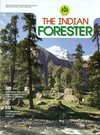Parasitic Association of Cuscuta with Polygonatum verticillatum Linn.
DOI:
https://doi.org/10.36808/if/2018/v144i6/130862Abstract
No Abstract.References
Aly R. (2007). Conventional and biotechnological approaches for control of parasitic weeds. In Vitro Cellular and Developmental Biology-Plant, 43 (4): 304-317.
Dawson J.H., Musselman L.J., Wolswinkel P. and Dorr I. (1994). Biology and control of Cuscuta. Reviews of Weed Science, 6: 265-317.
Garcia M.A., Costea M., Kuzmina M. and Stefanovic S. (2014). Phylogeny, character evolution, and biogeography of Cuscuta (dodders; Convolvulaceae) inferred from coding plastid and nuclear sequences. American J. Botany, 101 (4) : 670-690.
Hibberd J.M., Bungard R.A., Press M.C., Jeschke W.D., Scholes J.D. and Quick W.P. (1998). Localization of photosynthetic metabolism in the parasitic angiosperm Cuscuta reflexa. Planta, 205 (4): 506- 513.
Kaiser B., Vogg G., Furst U.B. and Albert M. (2015). Parasitic plants of the genus Cuscuta and their interaction with susceptible and resistant host plants. Frontiers in Plant Science, 6: 45.
Kanade M.B. and Gham S.K. (2010). Artificial inoculation of Cuscuta to non host plants. Geobios, 37(4): 341-342.
Kumar A., Mitra M., Adhikari B.S. and Rawat G.S. (2016). Flora of Niti Valley : a cold arid region of Nanda Devi Biosphere Reserve, Western Himalayas, India. www.biotaxa.org (Volume 12, Number 1, Article 1824, DoI : 10.15560/12.1.1824).
Kazmi I., Afzal M., Rahma M., Gupta G., and Anwar F. (2012). Aphrodisiac properties of Polygonatum verticillatum leaf extract. Asian Pacific Journal of Tropical Disease. 841-845.
Kuete V., Simo I. K., Ngameni B., Bigoga J. D., Watchueng J., Kapguep R. N., Etoa F. X., Tchaleu, B. N. and Beng V. P. (2007).
Antimicrobial activity of the methanolic extract, fractions and four flavonoids from the twigs of Dorstenia angusticornis Engl. (Moraceae). J. Ethnopharmacol., 112: 271-277.
Kumar A., Rani S. and Niketa S.S (2012). Recent review on plant molecular biology, phytophysiology, phytochemistry and ethnopharmacology of Cuscuta reflexa Roxb: A wonderful parasitic plant. Inter. Res. J. Pharmacy, 3 (7): 30-38.
Lee K.B. (2009). Structure and development of the endophyte in the parasitic angiosperm Cuscuta japonica. J. Plant Biology, 52: 355-363.
Oliveira I., Sousa A., Ferreira I.C., Bento A., Estevinho L. and Pereira J.A. (2008). Total phenols, antioxidant potential and antimicrobial activity of walnut (Juglans regia L.) green husks. Food Chem. Toxicol., 46: 2326-2331.
Saeed M., Khan H., Khan M.A., Simjee S.U., Muhammad N. and Khan S.A. (2010). Phytotoxic, Insecticidal and leishmanicidal activities of aerial parts of Polygonatum verticillatum. African J. Biotechnology, 9 (8): 1241-1244.
Van der Kooij T.A., Krause K., Dorr I. and Krupinska K. (2000). Molecular, functional and ultrastructural characterisation of plastids from six species of the parasitic flowering plant genus Cuscuta. Planta, 210: 701-707.
Woodford N. and Ellington M.J. (2007). The emergence of antibiotic resistance by mutation. Clin. Microbiol. Inf., 13: 5-18.
Downloads
Downloads
Published
How to Cite
Issue
Section
License
Unless otherwise stated, copyright or similar rights in all materials presented on the site, including graphical images, are owned by Indian Forester.





